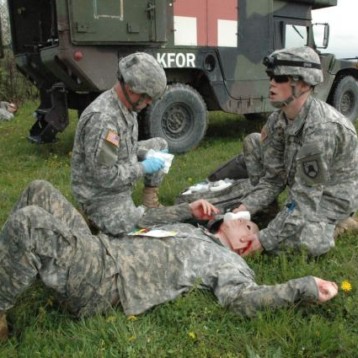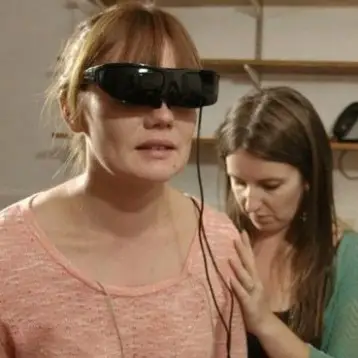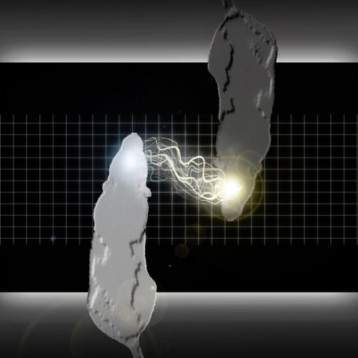|
Twenty five year old Phineas Gage was a normal man. The year was 1848, and Gage was the foreman of a railway construction project near the American town of Cavendish.
During the work laying the railway tracks, Gage’s team ran into a stubborn rock that blocked their progress. As was usual, the men drilled a deep hole in the rock and Gage was supposed to pour gunpowder into it, add the necessary fuse, seal the opening with sand and then tamp the charge with a long iron rod.
Gage did this, but made a huge mistake: he forgot to seal the hole with sand. He inserted the rod into the rock and pressed hard on the fuse itself. The result was a sudden explosion that fired the rod out the hole as if it was shot out of a canon (which was not far from the truth).
Gage couldn’t dodge the rod. It rammed into his face below his left cheek bone, entered his brain and the broke the skull on its way out. The rod, three feet long, went right through Gage’s brain and then landed in the ground some sixty feet behind him.
some sixty feet behind him.
In 99.9% of these types of cases, this kind of injury is fatal due to the massive trauma to the main blood vessels in the brain. But Phineas Gage did not die. He did not even lose consciousness. He was a bit dazed and let his pals walk him- on his feet, mind you- to a cart which took him to town.
|
A local doctor, Dr. Edward Williams, was rushed to the patient. He found Gage sitting at the stairs of a local hotel with his head between his hands, spitting blood. “What happened?” asked the doctor. Gage lifted his hat from his head, exposing the gaping hole in his skull. “Here is some work for you, doc” he said.
Dr. Williams did the best he could, cleaned the wound and restored some bones to their original location. A short time later another doctor joined him, Dr. John Harlow. Harlow was the senior of the two medical men and took charge of the case. After a few days it seemed as if Gage was truly on his way to a miraculous recovery. But was it a complete recovery?
The iron rod that pierced Gage went through an area in his brain called “the frontal lobe.” The frontal lobe is located in the front of the skull just behind the eyes and forehead, and its main function is to determine which actions are harmful and which are beneficial, preventing detrimental and inappropriate behavior, as well as understanding the consequences of our actions. The frontal lobe continues to grow and evolve well after our teen years, and it’s highly likely that the usual teenage wild and impulsive attitude is due to the frontal lobe’s “under-development” status. Then again, that fact does not make life easier for parents: someone once said that only mothers to teenage kids can truly understand why some animals eat their young.
|
Gage’s physician, Dr. Harlow, was the first to notice the changes in his behavior. He wrote that Gage behaved in a very childish manner and was almost impossible to control. When Gage recovered and returned home, his friends and relatives also noticed the impact of his injury. Once a balanced, well behaved, and responsible man, Gage became restless, moody, and inconsiderate. He could no longer plan ahead and stick with his plans. He even began to swear and curse, which he previously rarely did. His friend summed it all in one sad sentence: “He is no longer Phineas Gage.”
Not much in known about Gage’s story after he recovered from his wounds. The train company refused to accept him back due to his changed character, and he was forced to find alternative employment as a coach driver. He worked in South America for some time and died about twelve years later, in 1861.
Gage’s story became one of the most famous medical cases in brain research history. But still, Gage’s miracle did not contribute profoundly to understanding the way the brain works. No doctor examined his behavior before the accident (since he was totally anonymous then) so there was no real comparison with his character after it. The neurobiologists continued to stumble in the dark in their attempts to decipher the workings on the frontal lobe. They got their first real chance to investigate it properly only sixty years later, with the invention of the “lobotomy”, the medical procedure which became known as “the most barbaric mistake ever perpetrated by mainstream medicine.”
In 1890 a Swiss doctor working in a mental institution decided to try a revolutionary treatment. He removed the frontal lobe from six of his patients. One of them died immediately, one was found dead ten days later (perhaps a result of suicide), but the other four had undergone a radical change in their behavior. This crude experiment encouraged other researchers to investigate the possibilities of this kind of treatment on patients with severe mental disabilities: mentally handicapped with extreme violent behavior, sex perverts, and such. It was hoped that the changes due to the damage in the frontal lobe would have a net positive effect, since it couldn’t make things much worse.
Dr. Antonio Moniz created the operating procedure but the doctor whose name is forever bound to the lobotomy is the American Dr. Walter Freeman. Freeman started doing lobotomies in the thirties, when the whole idea was relatively unknown. He was not pleased with the current operating procedures of the time that required experienced surgeons and the expensive medical equipment that was only found in hospitals. Dr. Freeman hoped to bring the lobotomy to where it was really needed: to the mental institutions. There were patients there who could benefit immensely from this treatment, but there were no surgeons nor sophisticated equipment available at these institutions. Dr. Freeman hoped to find a way to perform the lobotomy in “field conditions”, one might say.
His solution was amazingly simple. All the other surgeons tried to reach the frontal lobe via the shortest route; that is, through the forehead. Freeman decided to reach his goal from a completely different direction; from the eyes. The following description might make some of the readers shift with unease, but from a surgical view point it was a bright idea. He took a long, sharp needle and inserted it above the eye and through the thin bones behind it. He entered the frontal lobe from below and when the needle was in the right place, he moved it from side to side, a-la wind shield wipers.
The impact of the lobotomy was extremely dramatic. In some cases the changes were beneficial and the violent or harmful behaviors were instantly gone. In other cases it had a devastating effect. Many patients became mentally handicapped or Catatonic, staring widely through the air without any indication of thoughts; empty shells.
Freeman was in love with his innovation. He was more then a doctor, he was a showman. He asked his assistants to time him and see how fast he could enter, cut and exit the brain. He inserted two needles into both eyes at once or in two patients at the same time. He did marathon surgeries, sometimes up to twenty five in one day.
There was no malice involved in thelobotomy. In times when there was neither cure nor medicine to people who suffered from cruel mental disorders and the lobotomy was the only way to ease the suffering of the patient and his family. In a situation where the only alternative was to lock the sick person in a padded cell, tied with a straight jacket for the rest of his life, there were doctors who saw the logic in this procedure. Still, the controversy surrounding lobotomy never died, both in the US and abroad.
The second half of the twentieth century saw a steady decline in the number of lobotomy operations, as more effective drug treatments were discovered. Doctors stopped recommending the operation in all but the most severe cases. Finally, the lobotomy was outlawed in many countries around the world. Dr. Freeman himself was forced to stop operating when a female patient died during an operation.
The frontal lobe has another important job in the brain beyond determining our personality. In the back of the frontal lobe near the middle of the skull is an area known as the sensory and motor cortex. It is the home of the Little Man, otherwise known as the Homunculus. The Little Man is the name given to a thin band of brain cells which are connected to the various body organs. They receive sensory input from them and control their movements. Neurobiologists became interested in the sensory and motor cortex due to a strange and disturbing phenomenon which no one could explain properly: phantom limbs.
In the US civil war, many soldiers suffered wounds that required doctors to amputate damaged limbs. Tens of thousands of soldiers returned home missing an arm or a leg but reported that they could still feel their amputated organs. I wish to stress this point: they were not imagining or fantasizing; they really felt the missing limb in the same manner that you and I can feel our arms and legs.
|
Their stories, and similar cases in later years, were so weird that they might have been considered fake, if it wasn’t for the fact that so many people reported the same phenomena. One woman said that when she approached a door, her phantom hand would try to grab the handle. A former professional tennis player described how his phantom hand would try to throw the ball into the air in an opening serve, or block his falls. Many patients felt real pains in their ghost limbs.
The first real insight about phantom limbs came only some fifteen years ago from research done by Dr. V.S. Ramachandran. His story (and many of the examples brought in this article) appears in his wonderful book, “Phantoms in the Brain”‘ which he co-wrote with Sandra Blakeslee.
Ramachandran discovered that in people who underwent an amputation, the area in the sensory cortex that was responsible for the now gone limb was invaded by the areas neighboring it. The facial area in the sensory cortex, for example, spread into the area that was once in charge of the missing arm, and the area governing the sex organs spread into the areas that used to control the leg. As a consequence, when the patient felt sexually aroused, for example, the brain mistook the sensory input as coming from the leg; or, to be more exact, from the area in the sensory cortex that the brain used to interpret as the leg area. When the patient moved his facial muscles, this movement was processed as an arm movement.
These ideas gave logical answers to cases in which phantom limbs appeared in other parts of the body, not only the limbs. Women who have had their breasts removed tell of phantom breasts. One patient insisted he could feel his appendix even after it was surgically removed. There is even a phantom penis, with ghost erections. One lucky patient described feeling his phantom leg coming to life only when having sex. He felt a sexual stimulation in his missing leg that was as strong as in his sex organs, and as a result had much more powerful orgasms than he had before he was injured. I’m sure he was not interested in medical assistance. He was just bragging.
About the author: Ran Levi has a B.Sc in Electrical Engineering from the Technion- Israel Institute of Technology. He has published a book about the history of Perpetual Motion Machines, and writes about various scientific and technological issues.












